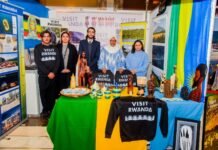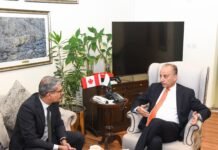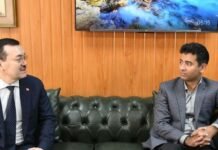Paris, 17 December 2022 (TDI): The leaders of France and Uzbekistan opened two significant exhibitions during the official visit of Uzbekistan’s Shavkat Mirziyoyev to France, at the invitation of France’s Emmanuel Macron.
The exhibitions are titled “The Splendours of Uzbekistan’s Oases. At the Crossroads of Caravan Routes” at the Louvre and “The Road to Samarkand. Miracles of Silk and Gold” at the Arab World Institute.
Both exhibits focus on the history and culture of Uzbekistan. The Louvre exhibition spans from the fifth and sixth centuries BC to the Timurid era.
The Arab World Institute features displays from the nineteenth and twentieth centuries, as well as artwork from the Turkestan avant-garde from the collection of the state museums of Uzbekistan.

Background
Shavkat Mirziyoyev, the President of Uzbekistan, made his first official trip to France in October 2018. An excursion to the Louvre was included in the cultural programme.
A large-scale exhibition honoring Uzbekistan’s rich historical and cultural heritage was already beginning to take shape at that point, and the Head of State enthusiastically endorsed it. It should be noted that a number of crucial events came before this.
Rocco Rante, an archaeologist and researcher, oversaw a team from the Samarkand Archeology Institute of the Academy of Sciences of the Republic of Uzbekistan in 2009 as they conducted an archaeological mission in Bukhara.
It was led by Jamal Mirzaakhmedov and later Abdisabur Raimkulov on the Uzbek side. 2011 saw Rante extend an invitation to former Louvre Director Henri Loyrette to visit Uzbekistan.

A decision was made to begin organizing a potential exhibition after evaluating the historical resources available; this planning took concrete form in 2017.
Later, while still in the Samarkand region of Uzbekistan, other excavations that were also carried out in collaboration with French experts uncovered a rare Zoroastrian carved panel. The discovery was touted as a major find.
The excavation site is thought to have been the location of the country palace used by the kings of pre-Islamic times (up until the eighth century).
Scientists believe that the three-tiered podium in the front room of the citadel, where the ruler sat on the throne, was where the panel simply adorned the hall walls. The podium took up the majority of the front room.
These were found alongside additional unusual discoveries. It became obvious that Uzbekistan would be able to impart to the world something extremely valuable in terms of history and culture.
A Partnership Agreement was signed between the Louvre Museum and the Art and Culture Development Foundation of Uzbekistan, which was represented by Executive Director Gayane Umerova.

Work on the preparations was overseen by the Deputy Chairperson of the Council of the Foundation, Saida Mirziyoyeva.
The Louvre exhibition was originally scheduled to take place in 2020–2021, but COVID-19 forced a postponement to 2022.
During this time, it became apparent that it would be logical to present an excursion into Uzbekistan’s ancient history, which would end in the 15th century, as well as to tell about subsequent periods up to the modern era, making this work comprehensive and finished.
Based on this, it was decided to hold two exhibitions: one at the Louvre, and the second at the Arab World Institute.
Four-year journey
Both exhibitions were prepared by a special commission. It was headed by the Prime Minister of the Republic of Uzbekistan and included Ministers, Scientists, Archaeologists, as well as Directors and Curators of museums from which it was intended to borrow artifacts.

It also included the Director of the Center for Islamic Civilization, Shoazim Minovarov, and Project Consultant, Shokir Pidayev.
The main restoration work started. Since 2018, more than 70 items have been specially restored for the exhibition.
A group of more than 40 restorers from France and Uzbekistan, including Marina Reutova, Kamoliddin Mahkamov, Shukhrat Pulatov, Christine Parisel, Olivier Tavoso, Delphine Lefebvre, Geraldine Frey, Axel Delau, Anne Liege, & others, participated in the project.
The conservation and restoration of the 8th-century Quranic pages from Kattalangar were particularly challenging and fascinating.
The Quran is one of the values that make up the cultural and historical heritage of all humanity and has great religious significance for Islam and Muslims.

The three-year restoration project was made possible in large part by Saida Mirziyoyeva, who was then serving as the Deputy Director of the Agency for Information and Mass Communications.
Saida Mirziyoyeva insisted on restoring all 13 pages, even though it was originally only intended to restore 2 pages.
The Alisher Navoi National Library, the Art and Culture Development Foundation, the Muslim Board of Uzbekistan, and the Ministry of Culture of the Republic of Uzbekistan all contributed to the restoration of this rare document. Axel Delau and Aurelia Streri, two Louvre Museum restorers, completed the work.
“The Splendours of Uzbekistan’s Oases. At the Crossroads of Caravan Routes”

“The Splendors of Uzbekistan’s Oases” exhibition
The history of the Great Silk Road, which passed through the southern part of modern-day Uzbekistan, is covered in the book “At the Crossroads of Caravan Routes,” which spans the time from the fifth and sixth centuries BC to the Timurid era.
It displays works of monumental art, wall paintings, carvings from palaces, handcrafted items, and more. 169 museum artifacts are featured in the exhibition, including 31 pieces from top museums around the globe and 138 artifacts from 16 museums in the Republic of Uzbekistan.
They include the British Museum, British Library, National Library of France, Cabinet of Medals in Paris, Victoria and Albert Museum in London, Guimet Museum, Languages and Civilizations University Library (BULAC), and Calouste Gulbenkian Foundation in Lisbon.

The exhibition’s curators are Rocco Rante and Yannick Lintz. As Saida Mirziyoyeva pointed out, trade and cultural exchange have always taken place in Uzbekistan, and the Great Silk Road has effectively evolved into the first major international economic initiative.
One of the main goals is to demonstrate the country’s distinctive heritage in the context of the world’s cultural traditions.
The exhibition at the Louvre will span roughly two thousand years and offer a multifaceted view of the culture of the various civilizations that have existed on the territory of modern-day Uzbekistan.
Rocco Rante then pointed out that the exhibition has two primary objectives. The first goal is to demonstrate Central Asian culture and civilization to Europeans.
The Louvre, one of the world’s top museums, is located in Paris, making it the ideal location for this. The second objective is to demonstrate how Central Asia and Europe have had strong historical ties.

After all, there are many historical events that these two regions have in common. The exhibition also serves as a way for European and French societies to learn more about Central Asia.
It has a significant historical presence and a culture rich in influential individuals. Rante added that over the next 30 to 40 years, the Louvre exhibition “The Splendours of Uzbekistan’s Oases. At the Crossroads of Caravan Routes” will become one of a kind.
In addition to the Katta Langar Quran, especially unique exhibits include a charred wooden panel from the settlement of Kafir-Kala, a statue of Buddha “Garland-bearer” (1st century BC – 1st century AD), the head of a Kushan prince from the settlement of Dalverzin-Tepe (1st-2nd centuries), the famous wall painting of the 7th century, depicting a hunting scene, found in the ancient settlement of Varakhsha in Bukhara region, a copy of the book of Marco Polo of the 14th century about his wanderings in Asia.
Simultaneously, because many archaeological discoveries and significant restoration work have been made over the last three years, a portion of the exposition will be shown to the public for the first time.

“The Road to Samarkand. Miracles of Silk and Gold”
This exhibition’s exposition, which includes over 300 exhibits from Uzbekistan’s 9 museums, includes objects of applied art, which are important elements of Uzbek identity and diversity.
Visitors can learn about national textiles, costumes, hats, jewelry from the 19th to the mid-20th centuries, gold embroidered chapans from the Bukhara-Emirate era, carpets, and much more.
The exhibition also includes 23 paintings from the collection of the State Museum of Arts of the Republic of Kazakhstan named after I. V. Savitsky in Nukus, including works by Turkestan avant-garde artists.
Turkestan was a popular geographical destination for Russian avant-garde artists between 1917 and 1932.

At a time when Matisse was discovering Morocco, avant-garde artists in search of “local color” found for themselves a unique source of inspiration in the richness of landscapes, forms, and faces of Central Asia.
A tobelik, a traditional headdress worn by Karakalpak women in the 17th and 18th centuries, is one of the most interesting exhibits here.
Tobelik is made of silver plates with coral and turquoise inserts and has a cylindrical shape. It is thought that it was used as an additional decoration, a kind of crown, on a saukele – a wedding headdress.
Kimesheks are also shown here. This is also a national headdress for women. Kimeshek completely covers the head, leaving the face open.
It appears to be a hood. Married women wore kimesheks of different colors to emphasize their status. Visitors’ attention will undoubtedly be drawn to arebeks, which are small nose rings.
They were made of gold and embellished with spiral curls, small turquoise and coral beads, and coral beads. Young Karakalpak women wore arebeks on the right wing of their noses, and these decorations are not found anywhere else in Uzbekistan.
If you draw parallels, they can be identified as a modern piercing analog. Paintings by Ural Tansikbayev, Victor Ufimtsev, and Nadejda Kashina are among those chosen.
Paintings by Alexander Volkov, Alexei Isupov, and others are on display. Despite their individual writing styles, all of the paintings are inspired and linked by a common theme: the East and its colors.
So, after viewing, for example, Nikolai Karakhan’s “Teahouse near the house under the elms,” the viewer can immediately understand how people dressed and rested their way of life, and the surrounding nature.

“Oriental Motif” by Victor Ufimtsev is a fascinating painting. The artist, a Siberian native, gradually mastered the traditional art of Islam as he traveled through Central Asia.
This piece is a free modernist stylization of a Muslim miniature depicting a classic banquet scene. A man with a vessel is moving towards two women who are resting in the painting.
Looking at this canvas, it appears that the Western viewer will be able to appreciate how high the respect for women has always been in the East.
In general, it should be noted that the Savitsky-entire Museum’s collection is intended to reveal all of the diversity, originality, and charm of oriental culture in general, and Uzbekistan in particular.
It is also significant that it will be presented at the Arab World Institute, which is located in the famous European capital. This once again demonstrates that the West and the East can coexist and enrich each other.
One of the exhibition’s curators, Yaffa Assouline, the head of the French publishing house Assouline Publishing, and photographer Laziz Hamani, assisted greatly in the creation of the exhibition.
They traveled across the region for three years looking for and collecting materials for Uzbekistan-related publications. “The Road to Samarkand” exhibition. “Miracles of Silk and Gold” became a living embodiment of these books.
The majority of the exhibits on display at the exhibition have never left Uzbekistan. Even those who are familiar with chapans, suzani, and other works on display in the country’s museums will see them in a new light and perspective – in 3D, which is an unprecedented experience.

Another useful aspect of the exhibition is the presentation of all regions of Uzbekistan at once, with their differences, schools, and manufacturing techniques.
As Gayane Umerova explained, collaboration with the Arab World Institute allows for a more in-depth exploration of Uzbekistan’s cultural context, emphasizing the significance and richness of its national heritage.
The Culture Foundation places a high value on exhibitions because one of its primary missions is to raise global awareness of Uzbekistan’s history and cultural heritage.
The exhibition is expected to appeal to a wide range of people interested in art, handicraft, and regional history.

Certainly, this project, developed in collaboration with the Arab World Institute, will help to further develop people’s mutual understanding and cooperation.
The ballet performance “Lazgi – Dance of Soul and Love” by German choreographer Raimondo Rebeck was presented at the exhibition’s opening ceremony.
The Khorezmian Lazgi dance dates back over 3000 years. It is listed on UNESCO’s Representative List of Intangible Cultural Heritage of Humanity.
The Silk Road’s territory contains traces and treasures from numerous civilizations and ethnic groups representing a wide range of cultures and ways of life.
This is a crossroads of many trade routes, an exchange of East and West, nomadic and sedentary lifestyles, and a synthesis of cultures from various civilizations, including Iranian, Hellenistic, Turkic, Chinese, Indian, Arab Muslim, Mongolian, and others.
Uzbekistan’s exhibitions in Paris will allow millions of people from all over the world to see the artifacts of this great history firsthand.
Experts believe that these exhibitions will be very effective because cultural cooperation quickly acquaints the country and people with the rest of the world. Every year, 60 million tourists visit France.

More than ten million people visit the Louvre each year. The fact that Uzbekistan will be represented at such a large-scale exhibition will increase awareness of the country and interest in its culture and history.
This will be an excellent advertisement for the growth of tourism. The more people learn about each other through exhibitions and mutual communication, the stronger their mutual trust. And trust opens the door to other areas of collaboration.
I'm a detail-oriented, problem-solving, persistent multitasker. Having a magna cum laude MSc. in Strategic Studies from National Defense University, Pakistan, I believe in peaceful discourse & dialogue and have built my interest in nontraditional security threats.
I am an experienced writer with a primary focus on public policy, environmental security, nuclear strategy, and geopolitics!








